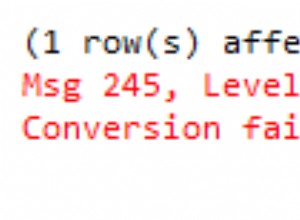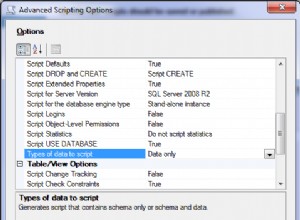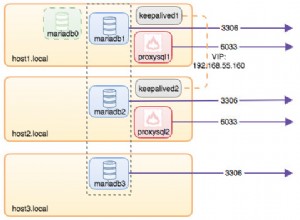मैं इवेंट प्रदर्शन रिपोर्टिंग के लिए निम्नलिखित का उपयोग करता हूं।
ध्यान दें कि यह कई अलग-अलग घटनाओं को संभाल सकता है (उदाहरण के लिए एन इवेंट जिन्हें आप अलग से कोड करते हैं) जिन्हें आप फेंकना चाहते हैं।
आप अपने ईवेंट के अंदर के चरणों के रूप में क्या करते हैं, यह आप पर निर्भर है। मेरे पास नीचे दिए गए ईवेंट में एक गैर-दिखाई गई तालिका का संदर्भ है और साथ ही मैं उस ईवेंट में क्या करता हूं जो इस एक व्यवसाय के लिए कस्टम है। वह सब दिखाने से यह उत्तर बहुत लंबा हो जाएगा। अगर आप एक इवेंट प्रोग्रामर हैं, तो आपको आपका . मिलेगा इसके लिए उपयोग करें।
साथ ही, WHILE मेरे ईवेंट में लूप तब तक सबसे अच्छा नहीं हो सकता जब तक आप उनके बिना कुछ साधारण ईवेंट कोड नहीं करते। यदि आप सुरक्षित रूप से WHILE से बाहर नहीं निकलते हैं, तो आपका ईवेंट हमेशा के लिए चलेगा। तो यहां कुछ भी हो तो इसे ध्यान में रखें।
स्कीमा स्टब
एक अद्वितीय id प्राप्त करने के एकमात्र उद्देश्य के लिए निम्न तालिका का उपयोग उसके कोड के शीर्ष के निकट एक ईवेंट द्वारा उसके विरुद्ध एक इंसर्ट करने के लिए किया जाता है लॉग टेबल में इन्सर्ट में उपयोग के लिए वापस। इसे डेटाटाइम कॉलम या पसंद के साथ विस्तारित करें। यह एक तुच्छ usedBy . दिखाता है कम से कम कुछ कैप्चर करने के लिए कॉलम, जैसे ईवेंट नाम। मुख्य रूप से, यह एक असाइन किए गए auto_increment को इससे वापस चाहता है (id )।
drop table if exists incarnations;
create table incarnations
( -- NoteA
-- a control table used to feed incarnation id's to events that want performance reporting.
-- The long an short of it, insert a row here merely to acquire an auto_increment id
id int auto_increment primary key,
usedBy varchar(50) not null
-- could use other columns perhaps, like how used or a datetime
-- but mainly it feeds back an auto_increment
-- the usedBy column is like a dummy column just to be fed a last_insert_id()
-- but the insert has to insert something, so we use usedBy
);
एक सामान्य लॉगिंग तालिका नीचे है:
drop table if exists EvtsLog;
create table EvtsLog
( id int auto_increment primary key,
incarnationId int not null, -- See NoteA (above)
evtName varchar(20) not null, -- allows for use of this table by multiple events
step int not null, -- facilitates reporting on event level performance
debugMsg varchar(1000) not null,
dtWhenLogged datetime not null
-- tweak this with whatever indexes your can bear to have
-- run maintenance on this table to rid it of unwanted rows periodically
-- as it impacts performance. So, dog the rows out to an archive table or whatever.
);
एक नमूना घटना
-- Now the event kicks in on the server on its interval schedule and processes the batch.
-- But we need to modify that Event code because prior all it did was write a row to the log table
-- saying it was looking around. But it didn't actually do anything
drop event if exists `Every_2_Minutes_QuestionUpdateImport`;
DELIMITER $$
CREATE EVENT `Every_2_Minutes_QuestionUpdateImport`
ON SCHEDULE EVERY 2 MINUTE STARTS '2015-09-01 00:00:00'
ON COMPLETION PRESERVE
DO BEGIN
DECLARE bContinue bool default true;
DECLARE counter int default 0;
DECLARE logMsg varchar(1000);
DECLARE incarnationId int default 0;
DECLARE evtAlias varchar(20);
-- right here you could save `now()` into a variable, let's call it STARTEVT
set evtAlias:='ev2minQUI'; -- a shorter unique alias name, max 20 chars
-- Below we must acquire our incarnation id from the control table used for all events
-- that want to use it. It facilitates performance reporting with the use of the `steps` column and the datetime
-- that are put in the EvtsLog table
insert incarnations(usedBy) values (evtAlias); -- see NoteA
select last_insert_id() into incarnationId; -- an auto_increment handed to us by the control table
insert EvtsLog(incarnationId,evtName,step,debugMsg,dtWhenLogged)
select incarnationId,evtAlias,1,'Event Fired, begin looking',now(); -- 1: we are beginning
WHILE bContinue DO -- this is an intermediate-level skills event example. Be careful or you are stuck in the event forever
select min(batchId) into @idToPerform
from EvtsQuestionsToImportBatchHandler -- table not shown in this post on Stackoverflow
where batchStatus=1; -- @idToPerform, a variable, will be null if there is no such row
insert EvtsLog(incarnationId,evtName,step,debugMsg,dtWhenLogged)
select incarnationId,evtAlias,5,'Debug Place 1',now();
IF (@idToPerform IS NOT NULL) THEN
-- This next update line is very crucial, to mark the batch as underway and never picked up again
-- at the top of this WHILE loop (otherwise you may be stuck in here forever)
update EvtsQuestionsToImportBatchHandler set batchStatus=2,dtProcessBegan=now() where [email protected];
set counter:=counter+1; -- used outside of the while loop in the end
insert EvtsLog(incarnationId,evtName,step,debugMsg,dtWhenLogged)
select incarnationId,evtAlias,10,"a message maybe from concat and variables",now();
--
-- Here is where you actually do something
-- Here is where you actually do something
-- Here is where you actually do something
insert EvtsLog(incarnationId,evtName,step,debugMsg,dtWhenLogged)
select incarnationId,evtAlias,20,"a message maybe from concat and variables",now();
-- Here is where you actually do something
-- Here is where you actually do something
-- Here is where you actually do something
insert EvtsLog(incarnationId,evtName,step,debugMsg,dtWhenLogged)
select incarnationId,evtAlias,30,"a message maybe from concat and variables",now();
-- mark this batch as done:
update EvtsQuestionsToImportBatchHandler set batchStatus=3,dtProcessFinished=now() where [email protected];
ELSE
set bContinue=false; -- we are done with the event loop
END IF;
-- if bContinue is true, we will seek the next batch to process that has batchStatus=1, if there is one
-- right here a new now() could be performed, and a timediff() against the STARTEVT
-- to determine if you want to bail out also with a " set bContinue=false; "
END WHILE; -- this is an intermediate-level skills event example. Be careful or you are stuck in the event forever
-- this msg is crucial to see in the log table to know you are not locking in an endless WHILE loop
set logMsg:=concat("Number of batches processed=",counter); -- concat example (could have been used above)
insert EvtsLog(incarnationId,evtName,step,debugMsg,dtWhenLogged)
select incarnationId,evtAlias,90,logMsg,now(); -- 90: we are almost done
insert EvtsLog(incarnationId,evtName,step,debugMsg,dtWhenLogged)
select incarnationId,evtAlias,99,'Event Done',now(); -- 99: we are done
END$$
DELIMITER ; -- sets the delimiter back to what we are used to, the semi-colon
स्वाभाविक रूप से, आपको लॉग तालिका के विरुद्ध प्रदर्शन रिपोर्टिंग मिलती है जिसमें incarnationId . शामिल है , evtName , step , और डेटटाइम। नीचे दी गई क्वेरी समय के अंतर के साथ बहु-पंक्ति ईवेंट जानकारी को 1 पंक्ति प्रति ईवेंट रन में संक्षिप्त कर देती है।
select incarnationId,dtBegin,dtEnd,TIMESTAMPDIFF(SECOND,dtBegin,dtEnd) as secDiff
from
( select incarnationId,min(dtBegin) as dtBegin,max(dtEnd) as dtEnd
from
( select incarnationId,
case
when step=1 then dtWhenLogged
end as dtBegin,
case
when step=99 then dtWhenLogged
end as dtEnd
from evtsLog
where evtName='evtName01'
) d1
group by incarnationId
) d2;
+---------------+---------------------+---------------------+---------+
| incarnationId | dtBegin | dtEnd | secDiff |
+---------------+---------------------+---------------------+---------+
| 101 | 2016-05-01 14:02:00 | 2016-05-01 14:02:01 | 1 |
| 102 | 2016-05-01 14:02:01 | 2016-05-01 14:02:07 | 6 |
+---------------+---------------------+---------------------+---------+
माइक्रोसेकंड में अधिक सटीक रिपोर्टिंग के लिए, MySQL 5.6.4 या इसके बाद के संस्करण की आवश्यकता है। यह देखें उत्तर ।
घटनाओं को लिखना मुश्किल है क्योंकि उनके साथ कोई UX जुड़ा नहीं है। लॉगिंग टेबल का उपयोग करके, आप न केवल प्रदर्शन रिपोर्टिंग प्राप्त कर सकते हैं, बल्कि उनके विकास के दौरान डिबगिंग संदेशों के साथ अंतर्दृष्टि भी प्राप्त कर सकते हैं।
लॉग टेबल के आकार को नियंत्रण में रखने के लिए उसकी छंटाई करना न भूलें। शायद इसे कहीं से संग्रहित कर रहा है (शायद किसी अन्य ईवेंट के माध्यम से!)।




